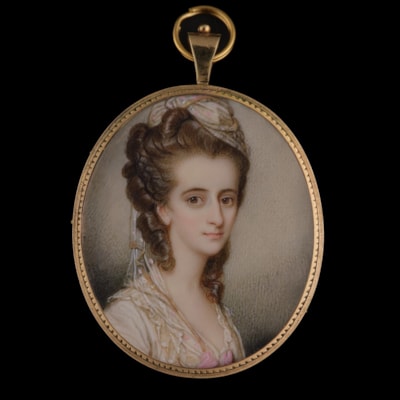Attributed to HUBERT DROUAIS
(1699-1767)Portrait miniature of a Lady, wearing a brown coat with fur lining, tied with blue ribbons, blue feathers in her hair, holding a fan, seated against a landscape background; circa 1760s
Circa 1760s
Oval, 4.5 cm (1 ³/₄ inches)
Watercolour on ivory (license number: 6M9Z7BWV)
Inscribed on the reverse ‘Hubert Drouais/ nach (?)/ Jean Marc Nattier/ d.J./ 17.3.1685 Paris … 1766/ Mme des Comminges’
£2,750
Nevertheless, the style of this miniature does still allow it to be attributed to Drouais. He was the father of François Hubert Drouais (1727-1775), known largely for his full-scale portraits, including one of Madame de Pompadour, in the National Gallery, London1. The Louvre also holds a number of his works in its collection, including some miniatures. However, Schidlof (1964) argues that many of the miniatures ascribed to the son are likely instead to be the work of his father.
The lady in this portrait is shown outside, and is wearing a fur-lined coat, a popular choice for French women in winter during this period. It is the numerous ribbons which adorn this coat which allow the miniature to be dated to the 1760s. These accessories, also practical in this instance as they are holding the lady’s coat closed, gained popularity in the late 1750s, worn by figures such as Madame de Pompadour. Her hair is adorned with feathers, the choice of many women of the period, alongside floral decorations. The closely curled styling of her hair is close to the popular ‘Tête de Mouton’ from the late 1750s and early 1760s. By the 1770s, such hairstyles would become much higher, and known as ‘poufs’, which required decoration with even more objects.
She also holds a fan- this is closed, but may have opened up to reveal a painted or printed scene, which were more common in the second half of the eighteenth century. Under Louis XIV (1638-1715), there had been a focus on increasing the export and reducing the import of many different commodities. Where fans had largely been produced in Italy before, economic changes had now allowed the French manufacture of fans to grow and occupy a large part of the European market. These could be produced according to various levels of extravagance, and used materials such as mother-of-pearl and precious metals for the base, as well as silk and gold thread in the leaf. It is said that one fan, owned by Madame Pompadour, featured ten miniatures and cuttings to resemble lace, and took nine years to make. Fans continued to be used as accessories for many years and were often produced as commemorative objects. One example, displayed at the Victoria and Albert Museum’s Marie Antoinette Style (2025), was produced as a souvenir for their wedding in 17702. Other fans believed to have been owned by the Dauphin, including one decorated a musical scene and decorated with sequins and rhinestones, are still extant3. These were often gifted to members of the court or other members of European Nobility, and gifted to Marie by admirers.
The fan in this miniature is held shut- according to the ‘Language of Fans’4, this means that the unknown lady is asking the viewer ‘Do you love me?’. Though it may not be known who she is or for whom the portrait was painted, it can be assumed that this was intended for an already established or potential beau. A portrait of Marie Antoinette, aged 14, at Innsbruck Palace, shows the young Dauphine holding a similarly closed fan, facing downwards, rather than upwards as in this portrait.
1. Inventory number NG6440.
2. V&A: 2193-1876.
3. In Musee Carnavalet, Paris, EV45.
4. Printed in the nineteenth century, by French Fan maker Dulvelleroy, but based on a long-standing language of fans used by women.

shipping notice
Worldwide shipping is included in all prices.
The Limner Company does not accept any responsibility for import duty, this is to be paid by the buyer.
Some stock items contain materials from endangered species which are governed by CITES regulations and will require a permit to export outside of Great Britain. If a certificate of export is required then this will be the responsibility of and paid for by the buyer .
you may also like



 +44(0)7983510056
+44(0)7983510056











